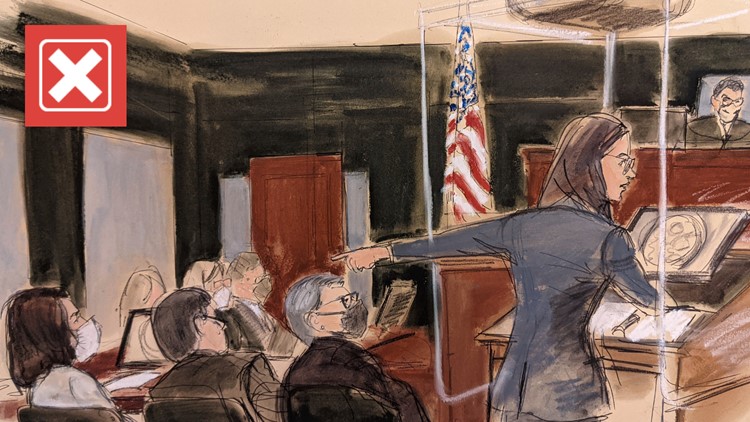UPDATE (4/27/22): On Dec. 30, 2021, Ghislaine Maxwell was convicted on five of six counts related to her role in Jeffrey Epstein's sexual abuse of minors. The trial was without broadcast through its completion. The original story continues as published.
The trial for Ghislaine Maxwell, who is accused of conspiring with Jeffrey Epstein to sexually abuse minors, began Nov. 29, 2021. But there was no livestream or television broadcast of the trial as there have been for other high-profile criminal cases this year, such as the trial of Kyle Rittenhouse and the trial of Derek Chauvin.
As a result, rumors about gag orders barring the public from viewing the case spread on social media. One such viral rumor came from UFC fighter Tim Kennedy, who claimed all press and spectators were barred from the courtroom.
THE QUESTION
Are press and spectators barred from the courtroom for Ghislaine Maxwell’s trial?
THE SOURCES
THE ANSWER
The press, the public and the alleged victims are allowed to observe Maxwell’s trial from inside the courtroom. However, a federal court rule forbids the broadcasting of federal criminal trials.
WHAT WE FOUND
Ghislaine Maxwell is currently on trial in a Manhattan federal court for allegedly “conspiring with Jeffrey Epstein to sexually abuse minors.” The U.S. Attorney for the Southern District of New York accuses her of “helping Jeffrey Epstein to recruit, groom, and ultimately abuse victims known to Maxwell and Epstein to be under the age of 18.”
The most recent document uploaded to the U.S. District Court for SDNY’s case information page for USA vs. Ghislaine Maxwell is an order from Judge Alison Nathan to keep access to the trial open to the alleged victims, the defendant’s family, the press and the public.
The order, dated Nov. 24, said the press and the public will have access to the trial through live video and audio feeds in overflow courtrooms. A previous order outlined four such overflow rooms would be available. However, the order also made clear federal rules prohibit the broadcasting of the trial.
The rule the order references is a preexisting law governing criminal trials in federal courts, Rule 53. “Except as otherwise provided by a statute or these rules, the court must not permit the taking of photographs in the courtroom during judicial proceedings or the broadcasting of judicial proceedings from the courtroom,” the rule says.
This law does not apply to state courts and trials, such as the recent high-profile trials of Kyle Rittenhouse and Derek Chauvin. According to the Radio Television Digital News Association (RTDNA)’s state-by-state guide to cameras in the court, Wisconsin allows “Three television cameras and three still photographers, using not more than 2 cameras each” in its courtrooms and Minnesota gives authority to a trial’s judge to grant or deny media requests to broadcast court proceedings. Rittenhouse was tried in a Wisconsin court, and Chauvin was tried in a Minnesota court.
The U.S. Attorney for the Southern District of New York, who is serving as the prosecution in Maxwell’s case, confirmed the public’s access to the trial with the limits on broadcasting.
“The Court will ensure public access (with COVID-19 distancing) to the trial in the courtroom itself and in several overflow rooms at the courthouse with live feeds of the proceedings,” the SDNY U.S. Attorney’s Office wrote. “Beyond the live feeds within the courthouse, the trial will not be further broadcast; nor will there be any telephonic dial-in to the proceedings.”
Courtroom sketch artists are allowed in the courtroom as media under federal rules, and many media outlets utilize them for their coverage when photographers are prohibited. For example, the Associated Press has a sketch artist for its daily coverage of the Maxwell trial. It is one of multiple media outlets to report from within the courtroom throughout the first days of the trial.



